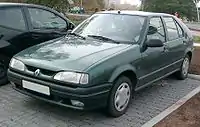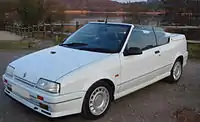Renault 19
The Renault 19 is a small family car that was produced by the French car manufacturer Renault between 1988 and 1996. In Turkey and in Argentina, production continued until 2000. The internal development code for the 19 was X53, with the five door receiving the B53 chassis code, the three door being the C53, the Chamade the L53, and the Cabriolet the D53.[2]
| Renault 19 | |
|---|---|
.jpg.webp) Renault 19 Phase 1 (hatchback) | |
| Overview | |
| Manufacturer | Renault |
| Also called | Renault Energy (Colombia, Venezuela) |
| Production |
|
| Assembly | |
| Designer | Giorgetto Giugiaro at Italdesign |
| Body and chassis | |
| Class | Small family car (C) |
| Body style | 3/5-door hatchback 4-door saloon ("Chamade") 2-door convertible |
| Layout | FF layout |
| Related | Renault Mégane I |
| Powertrain | |
| Engine | |
| Dimensions | |
| Wheelbase | 2,540 mm (100.0 in) |
| Length | Hatchback: 4,156 mm (163.6 in) Chamade: 4,248 mm (167.2 in) |
| Width | 1,694 mm (66.7 in) |
| Height | 1,412 mm (55.6 in) |
| Curb weight | 886–1,175 kg (1,953–2,590 lb) |
| Chronology | |
| Predecessor | Renault 9 / Renault 11 |
| Successor | Renault Mégane |
Overview




.jpg.webp)
The R19 was presented in June 1988,[3] with sales in the domestic French market beginning in September 1988.[4] It was the replacement for the 9 and 11, both of which were ageing and outdated by the end of the 1980s. The R19 went on sale in right hand drive form for the British market in February 1989.
The R19 was styled by Giorgetto Giugiaro, featuring Renault's new E-type (or "Energy") 1.4 L engine and F type 1.7 L versions. Base models originally used the OHV C-type Cléon 1.2 and 1.4 L engines, depending on the market. While originally only available with an atmospheric diesel engine, a turbocharged version appeared in the beginning of 1992.[5]
Intended to be Renault's last numeric named car, the 19 ushered in a new naming policy, with the saloon versions of the 19 being known as the 19 Chamade, to distinguish them from the hatchbacks. The saloon version was launched in 1989.[3] In many markets, the Chamade badge was dropped following the facelift of 1992, with some replacing it with the "Europa" tag.
In 1991, a convertible bodystyle built by Karmann was first shown; only a small number of these were built with the Phase I design as it was facelifted shortly thereafter. The convertible version went on sale in the beginning of 1992; it was only available with the two most powerful engine options.[6] Although the R19's exterior design (which was relatively conservative, like that of the Renault 9/11) received a muted response, it was praised for its interior comfort and handling.
For the fuel injected top versions, a four-speed automatic transmission became available in the fall of 1990. Lesser versions still made do with four- or five-speed manuals, or a three-speed automatic.[3]
In the summer of 1992, a revamped model was introduced with a substantially restyled front and rear, while LHD market versions received a new dashboard and interior — RHD models retained the original design.
With the facelift, smaller "Energy" series units gradually replaced the old pushrod items, and 1.8 litre engines appeared at the top of the lineup, where they replaced the more powerful 1.7 units (the F3N).[7] The R19 was sold in most of Europe until 1996, and was produced for some South American markets in Argentina until 2000 and for the Andean markets in Colombia until 2001. Turkish production lasted a little longer than in the rest of Europe, also until the year 2000. The R19's platform and running gear would continue to be used in its replacement, the first generation Renault Mégane, which lasted for seven years.
The Renault 19 was awarded the 1989 Car of the Year in Spain and Germany, 1990 Car of the Year in Ireland, and 1993 Car of the Year in Argentina. It was sold in limited numbers in Japan through Yanase Import Dealerships. The name "Chamade" wasn't used on Japanese-market saloons because it was too similar to the Daihatsu Charade, so these were called "Europa" instead.
16S


The Renault 19 16S (16V in some countries) was first shown towards the very end of 1988.[8] It was only actually added to the lineup in the autumn of 1990,[3] and was the only Renault 19 with a 16 valve engine. It had a distinctive air inlet on the bonnet, a rear spoiler, 15 inch Speedline SL401 alloy wheels, side skirts, twin headlamps, Recaro bucket seats with optional leather trim, four in one exhaust manifold and ABS braking system with optional trip computer, aircon and electric sunroof. The "S" is for Soupapes, French for valves.
It was praised for its excellent handling and rev happy F7P engine, which, along with the advanced Renix ECU, made it faster and more fuel efficient compared to most competitors. The braking system was upgraded to include 259 mm (10.2 in) vented discs on the front and 237 mm (9.3 in) discs on the rear as well as an uprated lower suspension setup and front strut bar.
Phase 1 editions benefited from unique front and rear bumpers with front indicators relocated into the bumpers to allow for the twin headlamps, while the Phase 2 retained the original bumpers found throughout the range but added colour coded tops, rubber inserts, and a discreet lower splitter. All bodystyles were offered with the 16 valve engine at one time or another, but were not available in all markets.
The last models (1995 to 1996) were called Executive and came with leather interior as standard.
A 16S version was also produced in Europe which was equipped as above – however, the earliest models did not sport the bonnet vent. The Phase 2 models gear ratios were also revised, to allow for the extra weight found in the safety equipment the later models carried.
Renault claimed an acceleration from 0 to 100 km/h (62 mph) of 8.2 seconds. Each model boasted 137 PS (101 kW; 135 hp) in a catalysed form and a top speed of 215 km/h (134 mph). Phase I included a non catalysed version with 140 PS (103 kW; 138 hp).[9]
Motorsport
Renault Sport used the 19 in the British Touring Car Championship in 1993, driven by Alain Menu and Tim Harvey. The car proved uncompetitive except in wet conditions, and was replaced with the Laguna for the 1994 season.
Engines
| Model | Engine | Displacement | Valvetrain | Fuel system | Max. power at rpm | Max. torque at rpm | Top speed | Years |
|---|---|---|---|---|---|---|---|---|
| Petrol engines | ||||||||
| 1.2 | C1G | 1237 cc | OHV 8v | Carburettor | 55 PS (40 kW; 54 hp) at 5000 rpm | 90 N⋅m (66 lb⋅ft) at 3000 rpm | 1988–199x | |
| 1.2e | E7F | 1171 cc | SOHC 8v | Single point fuel injection | 58 PS (43 kW; 57 hp) at 6000 rpm | 85 N⋅m (63 lb⋅ft) at 4000 rpm | 155 km/h (96 mph) | 1992–1995 |
| 1.4 | C1J | 1397 cc | OHV 8v | Carburettor | 60 PS (44 kW; 59 hp) at 5250 rpm | 101 N⋅m (74 lb⋅ft) at 2750 rpm | 1988–1989 | |
| 1.4 | C3J | 1397 cc | OHV 8v | Single point fuel injection | 58 PS (43 kW; 57 hp) at 4750 rpm | 100 N⋅m (74 lb⋅ft) at 3000 rpm | 161 km/h (100 mph) | 1989–1995 |
| 1.4 | E6J | 1390 cc | SOHC 8v | Carburettor | 80 PS (59 kW; 79 hp) at 5750 rpm | 108 N⋅m (80 lb⋅ft) at 2750 rpm | 176 km/h (109 mph) | 1988–1989 |
| 1.4 | E7J | 1390 cc | SOHC 8v | Single point fuel injection | 79 PS (58 kW; 78 hp) at 6000 rpm | 107 N⋅m (79 lb⋅ft) at 3500 rpm | 173 km/h (107 mph) | 1992–1995 |
| 1.61 | C2L | 1565 cc | OHV 8v | Carburettor | 78 PS (57 kW; 77 hp) at 5000 rpm | 123 N⋅m (91 lb⋅ft) at 3500 rpm | 1992–2000 | |
| 1.61 | C3L | 1565 cc | OHV 8v | Single point fuel injection | 75 PS (55 kW; 74 hp) at 5000 rpm | 133 N⋅m (98 lb⋅ft) at 5000 rpm | 1992–2000 | |
| 1.7 | F2N | 1721 cc | SOHC 8v | Carburettor | 75 PS (55 kW; 74 hp) at 5000 rpm | 125 N⋅m (92 lb⋅ft) at 3250 rpm | 1988–1989 | |
| 1.7 | F2N | 1721 cc | SOHC 8v | Carburettor | 92 PS (68 kW; 91 hp) at 5750 rpm | 138 N⋅m (102 lb⋅ft) at 3000 rpm | 183 km/h (114 mph) | 1988–1989 |
| 1.7 | F3N | 1721 cc | SOHC 8v | Single point fuel injection | 73 PS (54 kW; 72 hp) at 5000 rpm | 127 N⋅m (94 lb⋅ft) at 2750 rpm | 171 km/h (106 mph) | 1989–1995 |
| 1.7 | F3N | 1721 cc | SOHC 8v | Single point fuel injection | 90 PS (66 kW; 89 hp) at 5250 rpm | 140 N⋅m (103 lb⋅ft) at 3000 rpm | 185 km/h (115 mph) | 1989–1992 |
| 1.7 | F3N | 1721 cc | SOHC 8v | Multi point fuel injection | 107 PS (79 kW; 106 hp) at 5800 rpm | 151 N⋅m (111 lb⋅ft) at 4000 rpm | 190 km/h (118 mph) | 1990–1992 |
| 1.8 | F3P | 1794 cc | SOHC 8v | Single point fuel injection | 88 PS (65 kW; 87 hp) at 5750 rpm | 142 N⋅m (105 lb⋅ft) at 2750 rpm | 181 km/h (112 mph) | 1992–1994 |
| 1.8 | F3P | 1783 cc | SOHC 8v | Single point fuel injection | 90 PS (66 kW; 89 hp) at 5750 rpm | 144 N⋅m (106 lb⋅ft) at 2750 rpm | 181 km/h (112 mph) | 1994–1997 |
| 1.8 | F3P | 1794 cc | SOHC 8v | Multi point fuel injection | 109 PS (80 kW; 108 hp) at 5500 rpm | 160 N⋅m (118 lb⋅ft) at 4250 rpm | 195 km/h (121 mph) | 1992–1994 |
| 1.8 | F3P | 1783 cc | SOHC 8v | Multi point fuel injection | 107 PS (79 kW; 106 hp) at 5500 rpm | 158 N⋅m (117 lb⋅ft) at 4250 rpm | 195 km/h (121 mph) | 1994–1997 |
| 1.8 | F7P | 1764 cc | DOHC 16v | Multi point fuel injection | 135 PS (99 kW; 133 hp) at 6500 rpm | 158 N⋅m (117 lb⋅ft) at 4250 rpm | 212 km/h (132 mph) | 1990–1997 |
| Diesel engines | ||||||||
| 1.9 d | F8Q | 1870 cc | SOHC 8v | Indirect injection | 64 PS (47 kW; 63 hp) at 4500 rpm | 118 N⋅m (87 lb⋅ft) at 2250 rpm | 161 km/h (100 mph) | 1988–1995 |
| 1.9 dT | F8Q | 1870 cc | SOHC 8v | Indirect injection | 90 PS (66 kW; 89 hp) at 4250 rpm | 175 N⋅m (129 lb⋅ft) at 2250 rpm | 183 km/h (114 mph) | 1990–1995 |
1 Only for South America
Manufacturing factories
References
- "Istoria mărcii Dacia” - Partea a VIII-a: Primii ani"
- "Modellübersicht Renault" [Renault model listing]. Mobilverzeichnis (in German). Archived from the original on 5 October 2012. Retrieved 27 March 2013.
- Büschi, Hans-Ulrich, ed. (March 1991). Automobil Revue 1991 (in German and French). 86. Berne, Switzerland: Hallwag AG. p. 509. ISBN 3-444-00514-8.
- McNee, Stewart (22 July 1988). "Renault chases rivals". Evening Times (35, 171): 40.
- Büschi, Hans-Ulrich, ed. (5 March 1992). Automobil Revue 1992 (in German and French). 87. Berne, Switzerland: Hallwag AG. p. 490. ISBN 3-444-00539-3.
- Automobil Revue 1992, pp. 490-492
- Büschi, Hans-Ulrich, ed. (10 March 1994). Automobil Revue 1994 (in German and French). 89. Berne, Switzerland: Hallwag AG. pp. 478–479. ISBN 3-444-00584-9.
- Mastrostefano, Raffaele, ed. (January 1989). "Scavalcato il Turbo" [Skipping the turbo]. Quattroruote (in Italian). Vol. 34 no. 399. Milan, Italy: Editoriale Domus. p. 120.
- Automobil Revue 1991, p. 511
External links
| Wikimedia Commons has media related to Renault 19. |
- Brief history and technical specifications of the Renault 19
- Resource for Classic Renault owners and 19 Enthusiasts